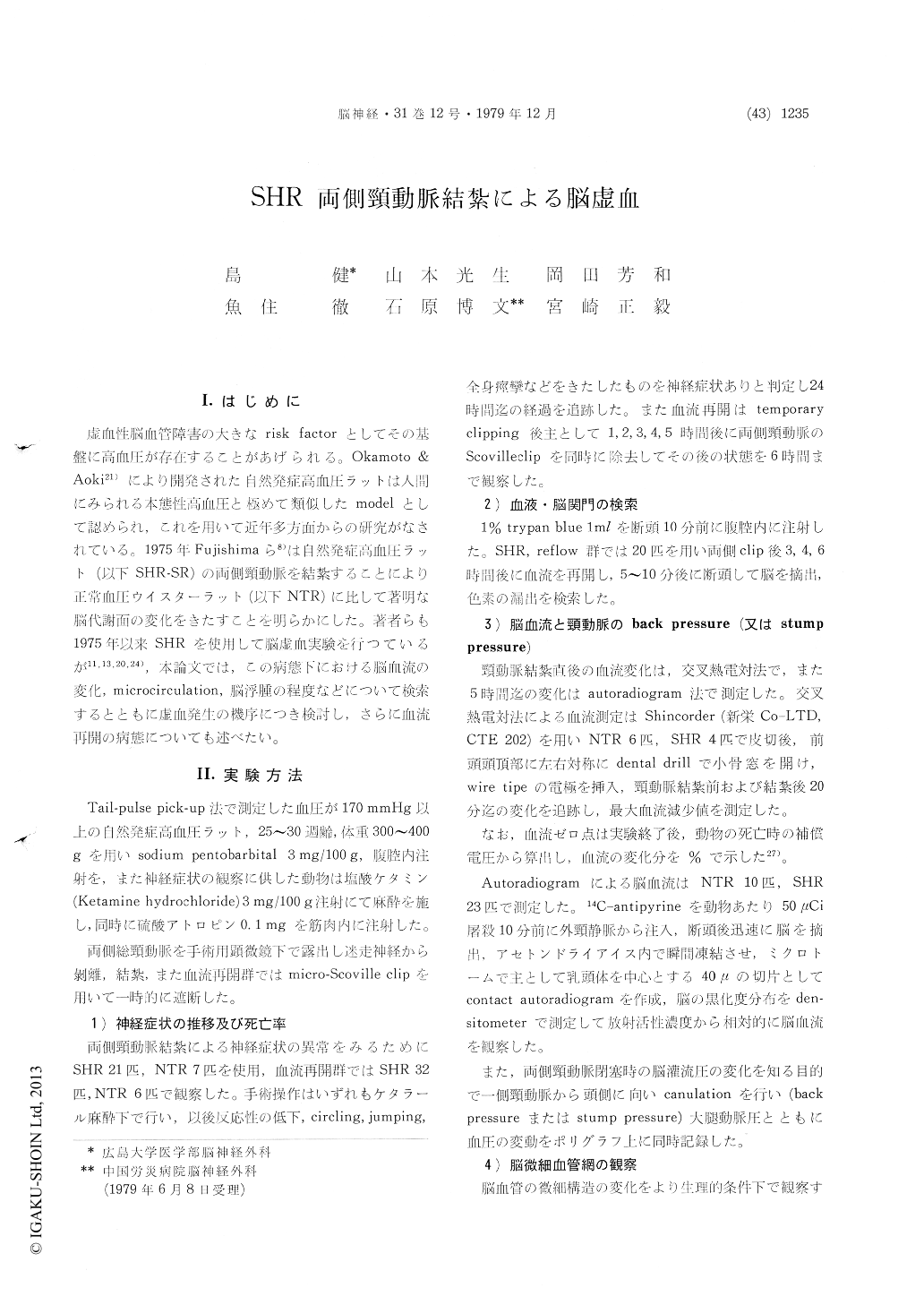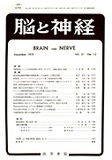Japanese
English
- 有料閲覧
- Abstract 文献概要
- 1ページ目 Look Inside
Ⅰ.はじめに
虚血性脳血管障害の大きなrisk factorとしてその基盤に高血圧が存在することがあげられる。Okamoto & Aoki21)により開発された自然発症高血圧ラットは人間にみられる本態性高血圧と極めて類似したmodelとして認められ,これを用いて近年多方面からの研究がなされている。1975年Fujishimaら8)は自然発症高血圧ラット(以下SHR-SR)の両側頸動脈を結紮することにより正常血圧ウイスターラット(以下NTR)に比して著明な脳代謝面の変化をきたすことを明らかにした。著者らも1975年以来SHRを使用して脳虚血実験を行つているが11,13,20,24),本論文では,この病態下における脳血流の変化,microcirculation,脳浮腫の程度などについて検索するとともに虚血発生の機序につき検討し,さらに血流再開の病態についても述べたい。
Using the spontaneously hypertensive rats (SHR) of Okamoto and Aoki, the authors performed ex-perimental study of the effects of carotid ligation and reflow on clinical state and microcirculation, and of carotid occlusion on cerebral blood flow and brain edema. Normotensive Wister-strain rats (NTR) and stroke resistant SHR, 5 to 6 months in age, were anesthetized with ketaral and pento-barbital. Bilateral common carotid arteries were isolated. The rats were classified into 2 groups, (1) the occluded group and (2) the reflow group in which the micro-clips were removed from both carotids 1 to 6 hours later.
Comparative studies were made on the following items. (1) clinical course, (2) changes in cerebral microcirculation and blood brain barrier and (3) cerebral blood flow. Water content of the brain was also calculated from protein measurement in SHR 1, 2, 3 and 4 hours after ligation.
The unilateral common carotid artery was cannulated cephalad for the recording of the back pressure. Cerebral blood flow was measured with the heated thermister method and autoradiographic technique using 14C-antipyrine. Blood-brain barrier was examined by intravenous injection of trypan blue. To study microcirculation, FITC-Textran (fluorescin isothiocyanate) of 40, 000 in molecular weight was injected intravenously and a fluorescentmicroangiogram of the brain was made.
(1) Occluded group:
After bilateral carotid occlusion of SHR, hyper-ventilation, restlessness, circling and convulsion were observed. The 24 hour mortality rate in SHR was 80%, while in NTR it was 14%. The back pressure of the carotid artery following bi-lateral carotid occlusion was 60 mmHg on an average in NTR and 27 mmHg in SHR respectively. Reduction of cortical flow was 56% in NTR and 83% in SHR immediately after ligation.
On the autoradiogram, adequate circulation was maintained in NTR even 5 hours after bilateral carotid occlusion. However, a definite reduction in cortical blood flow was found in SHR, 2 hours after occlusion.
In SHR, the water content of the brain increased significantly 4 hours after carotid occlusion and the increase in percentage was 2. 85 to the control level.
(2) Reflow group:
Distribution of blood flow, density of the capillary network and vascular pattern were well maintainedin NTR. Despite a marked reduction in the perfusion pressure, clinical recovery was atttained in SHR, when reflow was established within 2 or 3 hours. Although there were findings of filling defects at the level of the capillary in some parts, reactive hyperemia was recognized in the cortex on autoradiogram. If both carotids were released beyond 4 hours after occlusion, cerebral circulation could no longer be reestablished. A no-filling phenomenon and markedly increased permeability of the vessels were observed. Clinical recovery was not obtained at this stage.
These results suggested that the critical range of bilateral carotid occlusion in SHR is probably 3 hours. The severe ischemia in SHR is probably due to a marked drop in perfusion pressure, which may be caused by morphologically or functionally increased resistance of the cerebral vessels. The shift to a higher blood pressure level by the auto-regulation mechanism in SHR also must be con-sidered as one of the important causative factors.

Copyright © 1979, Igaku-Shoin Ltd. All rights reserved.


